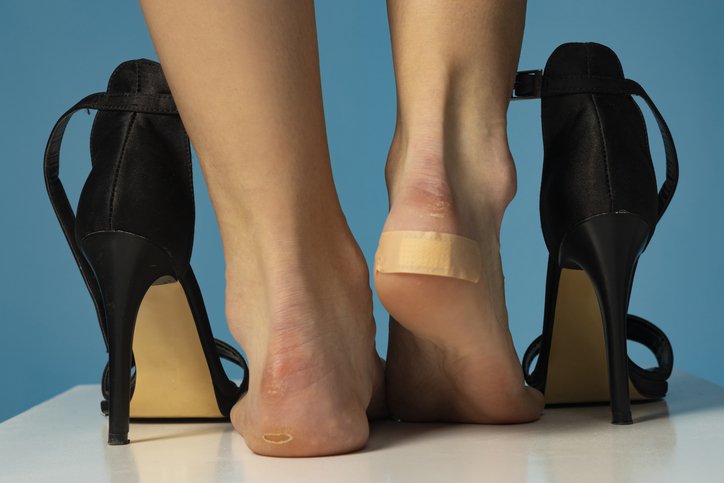Experts reveal perfect height for high heels
Updated | By Jacaranda FM
If your feet are screaming while you're wearing high heels, it might be time to listen.

Wearing high-heeled shoes can make you feel a lot of things.
Sexy, stylish, and powerful.
It can also make you feel pain.
READ: 12 high-paying jobs in SA that don't require a degree
While some might think "beauty is pain," it really doesn't have to be.
The truth is that towering heels can cause serious problems for your feet and knees, forcing you to walk the weary path to a podiatrist.
WATCH: Food influencers hit by car crashing into restaurant
Podiatrists diagnose and treat issues affecting the feet, ankles, and lower legs. They also perform surgery.
According to Dr. Ebonie Vincent-Sleet, a podiatrist and foot and ankle surgeon, high heels are the most common cause of chronic foot pain in women and can cause the following issues:
- neuromas
- bunions
- hammertoes
- stress fractures
- early-onset arthritis
Just yesterday, a patient came in asking about fat pad injections to make wearing heels more comfortable, which to me is a sign of how desperate some women are to maintain fashion while managing pain.- Dr. Ebonie Vincent-Sleet
WATCH: Man convinces entire Las Vegas club that he is famous singer
The issues also don't stem from the once-a-year occasion when you wear heels. Most often, the adverse outcome is the cumulative wear-and-tear effect from years of choosing fashionable but ill-fitting and unsupportive shoes.
Dr Vincent-Sleet says wearing these shoes is not worth it if you avoid outings or limp after events.
READ: Study reveals shocking impact of reality weight loss show
Here are what the experts recommend and some of their top tips:
1. The ideal heel height
Podiatrist and foot and ankle specialist Dr. Hira H. Mirza confirms that evidence-based studies support the ideal heel height.
Most experts suggest that heels be no higher than 5cm. Research shows that 7cm heels increase the forefoot pressure by 76% compared to flat shoes.
A 5cm heel increases the pressure by 57% and a 2cm heel by 22%.
Once you go over that 2-inch threshold, the biomechanics of the foot start to shift dramatically. Your weight pushes forward onto the ball of the foot, straining the metatarsals, shortening the Achilles tendon and putting the ankle at risk for instability. Over time, this leads to chronic pain and injury.- Dr. Ebonie Vincent-Sleet
Other doctors focus on additional metrics such as the heel-to-toe drop, which is the difference between the heel height and the ball of the foot.
READ: Popular car brand announces power supply monthly subscription for R390
2. How to find shoe styles that stabilise your feet
Shoe construction, not just height, is also important and can increase discomfort.
Your heels might be under 5cm, but you should also ensure the toe box is wide enough.
Pointy-toed shoes can cause nerve compression and bunions.
LISTEN: "My girlfriend doesn't want me working in OUR flat!"
Podiatrist Marion Yau Harley suggests the following styles for better support:
- platform heels
- block heels
- wedge heels
- strappy styles with secure fastenings
- open-toed shoes.
Platforms are the kindest options because they elevate the heel and forefoot. This reduces the incline and lessens the strain on the foot's arches, the ball of the foot, and the calf muscles. It also offers a lot more stability.
WATCH: Viewers shocked by new horror movie trailer
Block and wedge heels also offer a more solid, broader base, promoting even weight distribution. This reduces the pressure on the balls of the feet and the risk of ankle rolls.
Strappy styles provide extra security and prevent the foot from slipping forward. Feet slipping in heels is a common cause of instability and toe scrunching.
Open-toed shoes allows toes to move more freely and prevents them from being cramped by the steep incline, which leads to less pain and discomfort.- Marion Yau Harley (Podiatrist)
3. Prep your feet
One way to ward off blisters is to avoid buying shoes too close to the event's date. Most podiatrists recommend buying heels in advance, giving your feet a fair warning of what's to come.
You need to introduce new high heels very gradually. Wearing a brand-new pair for an extended period without a proper ‘breaking-in’ period can quickly lead to painful blisters and new formations of callus on pressure points, especially around the big toe.- Marion Yau Harley (Podiatrist)
They also suggest thin orthotics explicitly designed for heels, which can make a massive difference if you wear heels regularly.
Other helpful products include adhesive cushioning or targeted arch supports.
The final kicker, podiatrists will continue to spread the word that you don't have to be in pain because of the shoes you wear.
Our feet are the foundation of our movement, and the toll footwear choices take aren’t often noticed until pain sets in. Beauty shouldn’t come at the cost of your mobility. With a few swaps and some strategic plans for how to wear heels, it’s possible to stay stylish and protect your feet.- Dr. Anne Sharkey (Podiatrist)
Tune in to 'The Drive with Rob & Roz', on weekdays from 16:00 – 19:00. Stream the show live here or download our mobile app here.
Listen to Jacaranda FM:
- 94.2
- Jacaranda FM App
- http://jacarandafm.com
- DStv 858/ OpenView 602
Follow us on social media:
Image: iStock
More on Jacaranda FM
Show's Stories
-
Experts reveal perfect height for high heels
If your feet are screaming while you're wearing high heels, it might be ...
The Drive with Rob & Roz an hour ago -
12 high-paying jobs in SA that don't require a degree
No degree, big paycheck: These jobs South Africa pay big and don't need ...
The Drive with Rob & Roz 2 hours ago